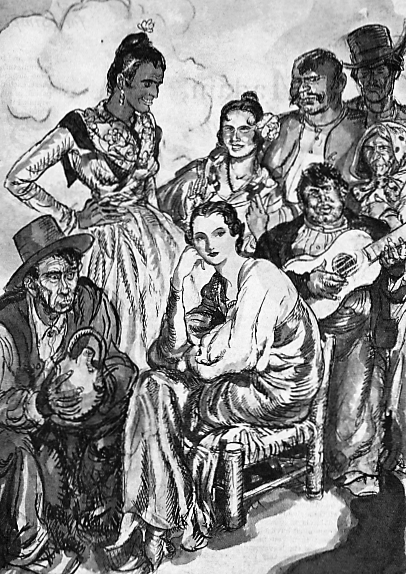
We’ll show her dressed to the nines, posing with a tribe of gypsies in the Pyrenees
illustration by Steven Spurrier for The Vanishing Star. A Comedy of Love and Strategy in Hollywood, by Reita Weiman, published in Britannia and Eve (London) of December 1932
The phrase dressed to the nines means dressed very elaborately or smartly.
It is first recorded in The Penny Wedding, published in The Herald (New York) of 11th March 1837:
A circumstance of a very engaging nature occurred last week at a house in the Broadway, not a hundred miles from the Bowling Green, which almost realized the Arabian tale of Aben Hassan. One evening a smart young mechanic, “dressed to the nines,” as Ben Bowline says, might have been seen wending his way along Broadway. His ais [sic] is thoughtful, yet gay—and his step light and elastic, betokens that
“Some unaccustomed spirit
Lifts him above the ground”
But lest some punster should suspect an invidious insinuation in the quotation, we declare that it was not the spirit of alcohol, but the spirit of love, which inspired him.
He was going to be married!
A similar phrase had been used in The Independent Gazetteer; or, The Chronicle of Freedom (Philadelphia, Pennsylvania) of 24th March 1787:
Last Saturday, one of those notorious villains, (distinguished by the appellation of sharper¹) dressed in his laced cloaths, and powdered off to the nines, went on board of a brig, bound for Calais, and enquired (with an audacious confidence) for the Captain, and informed him, a gentleman, at his lodgings, had some letters for that quarter.
(¹ The same text explains the term sharper; it says that, at cards, in the past, “persons who were observed to have superior skill in play, were then distinguished by the odious name of sharpers, and as such avoided by all men of sense—but now-a-days, they are complimented with the title of ‘connoisseur,’ and applauded for their understanding in all the niceties of the game, and that is looked upon as the most useful kind of learning, which teaches how to circumvent an adversary at the important business of whist.”)
These phrases are from the earlier to the nines (or, rarely, nine), meaning to perfection, to the highest degree or point, and first recorded in an epistle that the Scottish poet William Hamilton (circa 1665-1751) wrote on 24th July 1719 to the Scottish author Allan Ramsay (1686-1758):
When I receiv’d thy kind Epistle,
It made me dance, and Sing, and whistle […].
The bonny Lines therein thou sent me,
How to the Nines they did content me.
The origin of to the nines is obscure. The British lexicographer John Stephen Farmer (1854-1916) gave the most plausible explanation in his 1906 edition of The Proverbs, Epigrams, and Miscellanies of John Heywood. In Sixt Hundred Epigrammes, published in Iohn Heywoodes woorkes (1562), the English playwright and epigrammatist John Heywood (circa 1496-circa 1578) wrote:
Of crowes breedyng.
I woulde wish some good prouision to prouide,
That Crowes should neuer bréede by the hie waies side.
They so mistrust euery man to steale their burdes,
That no man can scape their opprobrious wurdes.
No man passeth by, what soeuer he bée,
But those crowes be knaue² him to the ninth degrée.
Should the crowes word stand when he ragis and raues,
We should haue in England fortie thousand knaues.
(² to beknave: to call ‘knave’)
And Farmer explained, about this particular epigram:
“to the ninth degree”, completely, perfectly, utterly: in modern phrase “up (or down) to the nines”.
The literal meaning of ninth degree is the ninth remove in the chain of kinship, especially the ninth generation of descent from a particular individual. By extension, the phrase to the ninth degree means to the greatest possible extent, to the maximum degree.
In Hard Cash. A Matter-of-Fact Romance (1863), the English author Charles Reade (1814-84) used the form to the nine several times:
Mrs. Beresford emerged, and walked the deck, quenching her austere regards with a familiar smile on Colonel Kenealy, her escort: this gallant, good-natured soldier flattered her to the nine, and, finding her sweeten with his treacle, tried to reconcile her to his old friend Dodd. Straight she soured, and forbade the topic imperiously.
[…]
The Honourable Mrs. Beresford and poodle hoisted on board, item her white maid, item her black nurse, item her little boy and male Oriental in charge thereof, the strangest compound of dignity and servility, and of black and white, being clad in snowy cotton and japanned to the nine.
[…]
The black desperado emerged on tiptoe from Kenealy’s cabin, just as Macbeth does from the murdered Duncan’s chamber: only with a pair of boots in his hand instead of a pair of daggers; got into the moonlight, and finding himself uninterrupted, assumed the whistle of innocence, and polished them to the nine, chuckling audibly.
